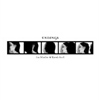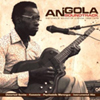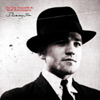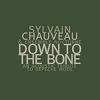Crouton
 Continuing the label's tradition of beautifully packaged, limited edition releases, Endingsis the second text + music project from Crouton founder Jon Mueller. Anestablished and diverse drummer, playing with indie instrumentalistsPele, Collections of Colonies of Bees, and a myriad of improvensembles, Mueller's written works offer unique glimpses into thestrange reality of a clearly eccentric artist whose role is nevermerely complimentary. Endings combines eleven very shortstories (in a boxed, spineless book) with a 30-min. CD-R of readingmusic, and several black-and-white illustrations by Kaveh Soofi, theBay Area graphic artist who designed the cover for Pele's last album.Mueller's stories are by far the most exciting piece of the puzzle. Theauthor uses the concept of "endings" to create postcard lengthvignettes launching the reader into a darkly absurd and chaotic worldwhere narrative seems to strive immediately toward a propheticconclusion. The extreme shortness of the texts provides that nocharacter or scenario is developed outside of a series of scrupulous,often ridiculous details serving only the anticipation of some unifyingfinale. Mueller always delivers the goods, in the sense that he hurlseach clipped plotline into an unmistakable, impassable "end;" howeverhis endings are never the epiphanies his stories require. Instead theyoffer only the further mystification of an already lost cast ofcharacters, managing to transform a clever variety of hum-drum pursuitsand circumstances into windows to another hellish dimension. A man,inexplicably followed while on the way to the grocery store, eventuallyconfronts his enraged pursuer, severs his own finger, and proceeds toreverse the chase, threatening the other man with the bloody appendage.Another character puts on a play for his dinner guests starring apicture of his dead son, whom he directs: "Sing, boy! Sing!" A businessexecutive returns from an emergency call to find his interruptedinterviewee sipping from the potential employer's coffee cup, his eyesrising in blank defiance. Most impressive is Mueller's ability tostreamline each story with a detail-driven first-person narrative thatassumes normalcy and connectedness, only to completely break down bythe end. More than simple plot twists, the author's endings might becalled 'anti-epiphanies' in the way they are positioned, through astriking economy of language, to effectively dismantle the story'sprior logic. Mueller's musical accompaniment is unlike anything I'veheard from him yet and clearly serves the box's theme. A fadedsymphonic loop plays over and over to simulate a continuous,regenerating "ending," essentially a false ending that, in its 19-sec.length, reminds me of the obscured, darkened tones of a Badalamentiscore played out like one of William Basinski's Disintegration Loops,only without disintegrating. The atmosphere is soothing for a smallsecond, but ultimately turns to a sinister, anxious tension, both aptand almost nauseating when coupled with Mueller's words. Soofi'sillustrations are less fitting, but interesting nonetheless. From thelook of it they are digital images arranged comic-strip-style butwithout any explicit narrative. The images are almost all stylized,grey toned portraits, progressively clouded, shadowed, fragmented,cropped, and later barraged by clusters of nail-covered blocks. I cansee comparisons to Francis Bacon's portraiture, with the sectionedmurkiness and sketchy inaccuracies reminding me of animations by SouthAfrican artist William Kentridge, though Soofi's work has an unsettlinggeometric base that feels very unique. Endings is well worth itto anyone keen on interesting packaging and multimedia formats; I amstill involved in picking apart and connecting the contents of thisbeautiful release, no end in sight.
Continuing the label's tradition of beautifully packaged, limited edition releases, Endingsis the second text + music project from Crouton founder Jon Mueller. Anestablished and diverse drummer, playing with indie instrumentalistsPele, Collections of Colonies of Bees, and a myriad of improvensembles, Mueller's written works offer unique glimpses into thestrange reality of a clearly eccentric artist whose role is nevermerely complimentary. Endings combines eleven very shortstories (in a boxed, spineless book) with a 30-min. CD-R of readingmusic, and several black-and-white illustrations by Kaveh Soofi, theBay Area graphic artist who designed the cover for Pele's last album.Mueller's stories are by far the most exciting piece of the puzzle. Theauthor uses the concept of "endings" to create postcard lengthvignettes launching the reader into a darkly absurd and chaotic worldwhere narrative seems to strive immediately toward a propheticconclusion. The extreme shortness of the texts provides that nocharacter or scenario is developed outside of a series of scrupulous,often ridiculous details serving only the anticipation of some unifyingfinale. Mueller always delivers the goods, in the sense that he hurlseach clipped plotline into an unmistakable, impassable "end;" howeverhis endings are never the epiphanies his stories require. Instead theyoffer only the further mystification of an already lost cast ofcharacters, managing to transform a clever variety of hum-drum pursuitsand circumstances into windows to another hellish dimension. A man,inexplicably followed while on the way to the grocery store, eventuallyconfronts his enraged pursuer, severs his own finger, and proceeds toreverse the chase, threatening the other man with the bloody appendage.Another character puts on a play for his dinner guests starring apicture of his dead son, whom he directs: "Sing, boy! Sing!" A businessexecutive returns from an emergency call to find his interruptedinterviewee sipping from the potential employer's coffee cup, his eyesrising in blank defiance. Most impressive is Mueller's ability tostreamline each story with a detail-driven first-person narrative thatassumes normalcy and connectedness, only to completely break down bythe end. More than simple plot twists, the author's endings might becalled 'anti-epiphanies' in the way they are positioned, through astriking economy of language, to effectively dismantle the story'sprior logic. Mueller's musical accompaniment is unlike anything I'veheard from him yet and clearly serves the box's theme. A fadedsymphonic loop plays over and over to simulate a continuous,regenerating "ending," essentially a false ending that, in its 19-sec.length, reminds me of the obscured, darkened tones of a Badalamentiscore played out like one of William Basinski's Disintegration Loops,only without disintegrating. The atmosphere is soothing for a smallsecond, but ultimately turns to a sinister, anxious tension, both aptand almost nauseating when coupled with Mueller's words. Soofi'sillustrations are less fitting, but interesting nonetheless. From thelook of it they are digital images arranged comic-strip-style butwithout any explicit narrative. The images are almost all stylized,grey toned portraits, progressively clouded, shadowed, fragmented,cropped, and later barraged by clusters of nail-covered blocks. I cansee comparisons to Francis Bacon's portraiture, with the sectionedmurkiness and sketchy inaccuracies reminding me of animations by SouthAfrican artist William Kentridge, though Soofi's work has an unsettlinggeometric base that feels very unique. Endings is well worth itto anyone keen on interesting packaging and multimedia formats; I amstill involved in picking apart and connecting the contents of thisbeautiful release, no end in sight.
samples:
 Hopelessly smitten by Buda Musique's long-defunct series of albums devoted to Angola, Analog Africa's Samy Ben Redjeb decided to try to pick up where his predecessors left off.  Characteristically, he quickly discovered that such an endeavor was much more convoluted and challenging than he had ever imagined, but ultimately made it through the gauntlet of denied visas, obligatory bribes, prohibitively expensive hotels, and ill-timed food poisoning to assemble what is possibly his finest compilation to date.
Hopelessly smitten by Buda Musique's long-defunct series of albums devoted to Angola, Analog Africa's Samy Ben Redjeb decided to try to pick up where his predecessors left off.  Characteristically, he quickly discovered that such an endeavor was much more convoluted and challenging than he had ever imagined, but ultimately made it through the gauntlet of denied visas, obligatory bribes, prohibitively expensive hotels, and ill-timed food poisoning to assemble what is possibly his finest compilation to date.


 I haven’t seen Dummy Jim yet, but if this soundtrack is any indication, it must be a truly unconventional and memorable film. With the aid of bizarre instrument builder Sarah Kenchington, Daniel Padden and his cohorts have created a kaleidoscopic collision of traditional Anglo-folk, free jazz, drone, and deep-seated eccentricity that sounds like absolutely no one else.
I haven’t seen Dummy Jim yet, but if this soundtrack is any indication, it must be a truly unconventional and memorable film. With the aid of bizarre instrument builder Sarah Kenchington, Daniel Padden and his cohorts have created a kaleidoscopic collision of traditional Anglo-folk, free jazz, drone, and deep-seated eccentricity that sounds like absolutely no one else. This is allegedly the swansong for Soundway’s excellent Panama! series- an unexpected choice, given that the rich vein of material doesn’t show the slightest sign of being exhausted (perhaps the compilers just need some time away from the heat and the mosquitoes). Though the focus has shifted away from funk this time, this third volume remains every bit as exuberant, smoldering, absurd, and fun as its predecessors.
This is allegedly the swansong for Soundway’s excellent Panama! series- an unexpected choice, given that the rich vein of material doesn’t show the slightest sign of being exhausted (perhaps the compilers just need some time away from the heat and the mosquitoes). Though the focus has shifted away from funk this time, this third volume remains every bit as exuberant, smoldering, absurd, and fun as its predecessors. 2009 has certainly been a great year for this young banshee from Wisconsin. Zola Jesus has put out numerous releases this year, each featuring high quality songwriting and production. To have so many releases of such a high quality is truly impressive, and this collection continues that hot streak.
2009 has certainly been a great year for this young banshee from Wisconsin. Zola Jesus has put out numerous releases this year, each featuring high quality songwriting and production. To have so many releases of such a high quality is truly impressive, and this collection continues that hot streak. Sylvain Chauveau’s acoustic tribute to Depeche Mode starts off well but soon plummets into a chasm of middle of the road yawns. Down to the Bone is less of a tribute and more of an insult.
Sylvain Chauveau’s acoustic tribute to Depeche Mode starts off well but soon plummets into a chasm of middle of the road yawns. Down to the Bone is less of a tribute and more of an insult. Eight new broadcasts from the chilly world of the Arctic Lofoten Islands are made available on this double disc and, in some ways, they all exemplify just how much Steven Stapleton must be falling in love with digital sound stretching. Just as the first volume was an effort to reshape the world around them in sound, the second volume of Shipwreck Radio turns the world of Lofoten into a strange place occupied by distortions of the Arctic's natural sound world.
Eight new broadcasts from the chilly world of the Arctic Lofoten Islands are made available on this double disc and, in some ways, they all exemplify just how much Steven Stapleton must be falling in love with digital sound stretching. Just as the first volume was an effort to reshape the world around them in sound, the second volume of Shipwreck Radio turns the world of Lofoten into a strange place occupied by distortions of the Arctic's natural sound world. For their latest collaboration, Boris and Merzbow have produced an elemental and tempestuous album. It sounds like a year’s worth of weather condensed into the space of a CD.
For their latest collaboration, Boris and Merzbow have produced an elemental and tempestuous album. It sounds like a year’s worth of weather condensed into the space of a CD. Story goes that a friend or fan passed ex-Can vocalist Damo Suzuki aCul de Sac record on the lucky hunch that he'd find a kindred spirit inthe Boston hard psych outfit's instrumental, eastern-leaning, andpercussion-heavy sound. Suzuki was apparently so impressed that heproposed a massive series of all-improvised live dates with the band,spanning two years and several continents, and beginning without thehelp of a single rehearsal. Abhayamudra'stwo discs collect the best moments from over 40 shows, and despite therecent flood of classic Can reissues/remasters, it's hard not to beimpressed by the fruits of this complimentary union. Cul de Sac'stalents for improvisation have been well established by a string ofambitious, often conceptual full-length releases, but their ability toaccommodate Suzuki's iconoclastic style of nonsense trance rambling iscontinually surprising and entirely capable of spanning Abhayamudra's2+ hours without a drift into the pained repetition common amongkraut-imitators. What the band lacks of Can's funk (nearly all of it)they make up for in an intensely layered and propulsive performance,due in large part to Glenn Jones' guitar, bridging delicate raga motifsand wall-of-feedback charges with the control of and responsivetechnique of a virtuoso. Jon Proudman's drumming steers from Can'sexultant rhythms toward darker, flooding beats that fill every gap, andevery percussion junkie's expectation, without ever sounding like toomuch. Suzuki's vocal, no doubt in response to the decreased buoyancy ofthe music and the stresses of constant improv, takes a moreaccompanying approach here than ever with Can, becoming a steady streamof multi-syllabic, often predictably deconstructed language. A fewsections find the vocalist reaching for more guttural sounds andengaging the extremes of his unique instrument, but Suzuki'sperformance, at least here on disc, leaves me wanting more variation.The band is able to cover the slack with dips into its elegantdrone-based recent work and the burstings of a rougher-hewn, crassersound than I ever thought they were capable. Suzuki's improvisedinclusion, it seems, has succeeded in breaking down a bit of Cul deSac's studied underpinnings, but at the cost of some of the singer'sexpressiveness, though I would argue that Suzuki's talent suffersmainly as a result of his self-imposed doctrine of improvisation. Whileno doubt conceived in an improvised setting, Suzuki's most impressivework with his former band feels too often linked to the dramatic andconstructed song elements that are necessarily absent here. Thesecriticisms are of course relative, and fans of either party will surelyfind more than a few sections within these discs to embraceunreservedly. Most impressive, though, will be the amount ofunrehearsed magic that these short hours represent, a significantachievement regardless of past prejudice. A studio session might evenhave produced too conflicted or divisive a meeting of suchauthoritative forces.
Story goes that a friend or fan passed ex-Can vocalist Damo Suzuki aCul de Sac record on the lucky hunch that he'd find a kindred spirit inthe Boston hard psych outfit's instrumental, eastern-leaning, andpercussion-heavy sound. Suzuki was apparently so impressed that heproposed a massive series of all-improvised live dates with the band,spanning two years and several continents, and beginning without thehelp of a single rehearsal. Abhayamudra'stwo discs collect the best moments from over 40 shows, and despite therecent flood of classic Can reissues/remasters, it's hard not to beimpressed by the fruits of this complimentary union. Cul de Sac'stalents for improvisation have been well established by a string ofambitious, often conceptual full-length releases, but their ability toaccommodate Suzuki's iconoclastic style of nonsense trance rambling iscontinually surprising and entirely capable of spanning Abhayamudra's2+ hours without a drift into the pained repetition common amongkraut-imitators. What the band lacks of Can's funk (nearly all of it)they make up for in an intensely layered and propulsive performance,due in large part to Glenn Jones' guitar, bridging delicate raga motifsand wall-of-feedback charges with the control of and responsivetechnique of a virtuoso. Jon Proudman's drumming steers from Can'sexultant rhythms toward darker, flooding beats that fill every gap, andevery percussion junkie's expectation, without ever sounding like toomuch. Suzuki's vocal, no doubt in response to the decreased buoyancy ofthe music and the stresses of constant improv, takes a moreaccompanying approach here than ever with Can, becoming a steady streamof multi-syllabic, often predictably deconstructed language. A fewsections find the vocalist reaching for more guttural sounds andengaging the extremes of his unique instrument, but Suzuki'sperformance, at least here on disc, leaves me wanting more variation.The band is able to cover the slack with dips into its elegantdrone-based recent work and the burstings of a rougher-hewn, crassersound than I ever thought they were capable. Suzuki's improvisedinclusion, it seems, has succeeded in breaking down a bit of Cul deSac's studied underpinnings, but at the cost of some of the singer'sexpressiveness, though I would argue that Suzuki's talent suffersmainly as a result of his self-imposed doctrine of improvisation. Whileno doubt conceived in an improvised setting, Suzuki's most impressivework with his former band feels too often linked to the dramatic andconstructed song elements that are necessarily absent here. Thesecriticisms are of course relative, and fans of either party will surelyfind more than a few sections within these discs to embraceunreservedly. Most impressive, though, will be the amount ofunrehearsed magic that these short hours represent, a significantachievement regardless of past prejudice. A studio session might evenhave produced too conflicted or divisive a meeting of suchauthoritative forces. While the days of guitar maximalism are long in Cranes' past, Particles & Waves showcases a band who is doing a very good job when they attempt to recapture the stunningly haunting sound that drew so many fans a decade ago. On songs like "K56," and "Here Comes the Snow," Alison Shaw's piercingly high pitched voice is fragile and lonely, almost naked against the patient and pretty melodies. However, there are certain points where I simply cannot connect with the music.
While the days of guitar maximalism are long in Cranes' past, Particles & Waves showcases a band who is doing a very good job when they attempt to recapture the stunningly haunting sound that drew so many fans a decade ago. On songs like "K56," and "Here Comes the Snow," Alison Shaw's piercingly high pitched voice is fragile and lonely, almost naked against the patient and pretty melodies. However, there are certain points where I simply cannot connect with the music. Continuing the label's tradition of beautifully packaged, limited edition releases, Endingsis the second text + music project from Crouton founder Jon Mueller. Anestablished and diverse drummer, playing with indie instrumentalistsPele, Collections of Colonies of Bees, and a myriad of improvensembles, Mueller's written works offer unique glimpses into thestrange reality of a clearly eccentric artist whose role is nevermerely complimentary. Endings combines eleven very shortstories (in a boxed, spineless book) with a 30-min. CD-R of readingmusic, and several black-and-white illustrations by Kaveh Soofi, theBay Area graphic artist who designed the cover for Pele's last album.Mueller's stories are by far the most exciting piece of the puzzle. Theauthor uses the concept of "endings" to create postcard lengthvignettes launching the reader into a darkly absurd and chaotic worldwhere narrative seems to strive immediately toward a propheticconclusion. The extreme shortness of the texts provides that nocharacter or scenario is developed outside of a series of scrupulous,often ridiculous details serving only the anticipation of some unifyingfinale. Mueller always delivers the goods, in the sense that he hurlseach clipped plotline into an unmistakable, impassable "end;" howeverhis endings are never the epiphanies his stories require. Instead theyoffer only the further mystification of an already lost cast ofcharacters, managing to transform a clever variety of hum-drum pursuitsand circumstances into windows to another hellish dimension. A man,inexplicably followed while on the way to the grocery store, eventuallyconfronts his enraged pursuer, severs his own finger, and proceeds toreverse the chase, threatening the other man with the bloody appendage.Another character puts on a play for his dinner guests starring apicture of his dead son, whom he directs: "Sing, boy! Sing!" A businessexecutive returns from an emergency call to find his interruptedinterviewee sipping from the potential employer's coffee cup, his eyesrising in blank defiance. Most impressive is Mueller's ability tostreamline each story with a detail-driven first-person narrative thatassumes normalcy and connectedness, only to completely break down bythe end. More than simple plot twists, the author's endings might becalled 'anti-epiphanies' in the way they are positioned, through astriking economy of language, to effectively dismantle the story'sprior logic. Mueller's musical accompaniment is unlike anything I'veheard from him yet and clearly serves the box's theme. A fadedsymphonic loop plays over and over to simulate a continuous,regenerating "ending," essentially a false ending that, in its 19-sec.length, reminds me of the obscured, darkened tones of a Badalamentiscore played out like one of William Basinski's Disintegration Loops,only without disintegrating. The atmosphere is soothing for a smallsecond, but ultimately turns to a sinister, anxious tension, both aptand almost nauseating when coupled with Mueller's words. Soofi'sillustrations are less fitting, but interesting nonetheless. From thelook of it they are digital images arranged comic-strip-style butwithout any explicit narrative. The images are almost all stylized,grey toned portraits, progressively clouded, shadowed, fragmented,cropped, and later barraged by clusters of nail-covered blocks. I cansee comparisons to Francis Bacon's portraiture, with the sectionedmurkiness and sketchy inaccuracies reminding me of animations by SouthAfrican artist William Kentridge, though Soofi's work has an unsettlinggeometric base that feels very unique. Endings is well worth itto anyone keen on interesting packaging and multimedia formats; I amstill involved in picking apart and connecting the contents of thisbeautiful release, no end in sight.
Continuing the label's tradition of beautifully packaged, limited edition releases, Endingsis the second text + music project from Crouton founder Jon Mueller. Anestablished and diverse drummer, playing with indie instrumentalistsPele, Collections of Colonies of Bees, and a myriad of improvensembles, Mueller's written works offer unique glimpses into thestrange reality of a clearly eccentric artist whose role is nevermerely complimentary. Endings combines eleven very shortstories (in a boxed, spineless book) with a 30-min. CD-R of readingmusic, and several black-and-white illustrations by Kaveh Soofi, theBay Area graphic artist who designed the cover for Pele's last album.Mueller's stories are by far the most exciting piece of the puzzle. Theauthor uses the concept of "endings" to create postcard lengthvignettes launching the reader into a darkly absurd and chaotic worldwhere narrative seems to strive immediately toward a propheticconclusion. The extreme shortness of the texts provides that nocharacter or scenario is developed outside of a series of scrupulous,often ridiculous details serving only the anticipation of some unifyingfinale. Mueller always delivers the goods, in the sense that he hurlseach clipped plotline into an unmistakable, impassable "end;" howeverhis endings are never the epiphanies his stories require. Instead theyoffer only the further mystification of an already lost cast ofcharacters, managing to transform a clever variety of hum-drum pursuitsand circumstances into windows to another hellish dimension. A man,inexplicably followed while on the way to the grocery store, eventuallyconfronts his enraged pursuer, severs his own finger, and proceeds toreverse the chase, threatening the other man with the bloody appendage.Another character puts on a play for his dinner guests starring apicture of his dead son, whom he directs: "Sing, boy! Sing!" A businessexecutive returns from an emergency call to find his interruptedinterviewee sipping from the potential employer's coffee cup, his eyesrising in blank defiance. Most impressive is Mueller's ability tostreamline each story with a detail-driven first-person narrative thatassumes normalcy and connectedness, only to completely break down bythe end. More than simple plot twists, the author's endings might becalled 'anti-epiphanies' in the way they are positioned, through astriking economy of language, to effectively dismantle the story'sprior logic. Mueller's musical accompaniment is unlike anything I'veheard from him yet and clearly serves the box's theme. A fadedsymphonic loop plays over and over to simulate a continuous,regenerating "ending," essentially a false ending that, in its 19-sec.length, reminds me of the obscured, darkened tones of a Badalamentiscore played out like one of William Basinski's Disintegration Loops,only without disintegrating. The atmosphere is soothing for a smallsecond, but ultimately turns to a sinister, anxious tension, both aptand almost nauseating when coupled with Mueller's words. Soofi'sillustrations are less fitting, but interesting nonetheless. From thelook of it they are digital images arranged comic-strip-style butwithout any explicit narrative. The images are almost all stylized,grey toned portraits, progressively clouded, shadowed, fragmented,cropped, and later barraged by clusters of nail-covered blocks. I cansee comparisons to Francis Bacon's portraiture, with the sectionedmurkiness and sketchy inaccuracies reminding me of animations by SouthAfrican artist William Kentridge, though Soofi's work has an unsettlinggeometric base that feels very unique. Endings is well worth itto anyone keen on interesting packaging and multimedia formats; I amstill involved in picking apart and connecting the contents of thisbeautiful release, no end in sight.
